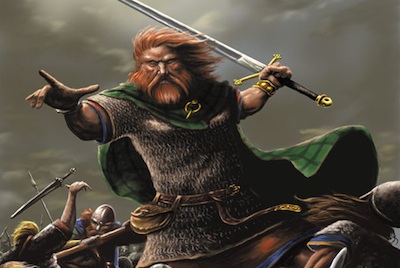
A struggle to free Ireland of foreign domination resulted in a heroic victory -- but the death of a great Irish leader -- a thousand years ago this week.
The events that took place at the Battle of Clontarf on Good Friday, April 23rd, 1014 were the culmination of two centuries of strife, treachery, failed alliances and treaties between the Irish Celtic chieftains themselves on the one hand and their relationships with the invading Norsemen who had taken a foothold in Ireland.
The first Norsemen or Vikings had arrived in Ireland some two centuries before, initially plundering the gold, chalices, crosses and manuscripts of the monasteries and the corn harvests of the settled communities. Gradually they established Viking settlements around Ireland and engaged in trade and commerce.
There was, however, significant opposition to their presence in Ireland, not least in Munster where King Brian Boru had defeated their armies on several occasions. Brian’s aim was to unite all the warring Celtic kingdoms under one rule and one High King.
Prelude to Battle
In 1013, Mael Mordha, the king of Leinster went into revolt after inter-marriage alliances with Brian had broken down, and joined forces with the Vikings. Together, they initially attacked the kingdom of Mael Sechlainn of Meath who summoned the help of King Brian.
Brian set off towards Dublin with 4,900 troops made up 2,000 Munster men, 1,400 Dalcassians (also Munster men), and 1,500 Connacht clansmen. Opposing them were Mael Mordha’s army of 4,000 Leinster men allied to 3,000 Viking warriors.
The Battle Ground
Although but a small segment of the battle was fought close to the seafront at Clontarf, the historic encounter of Good Friday 1014 entered the annals as the Battle of Clontarf. This was largely because some 2,000 Vikings had by sunrise on that morning of April 23rd, landed in longboats at Clontarf.
As the two opposing armies faced one another that day the Vikings and the Leinster men were lined across the sloping plains bounded by the sea and the River Tolka, while King Brian’s army occupied the rising ground near Tomar’s Wood in Phibsboro.
The most ferocious part of the battle was fought at ‘the Battle of the Fishing Weir’, which approximates to the site of the former D.W.D. Whiskey Distillery on Richmond Road. Historic accounts of the battle also refer to the ‘savage encounters’ fought on the ‘Bloody Fields of Marino’ and what is today Phibsboro and Cross Guns.
Battle Victory for Brian
The result of the bloodiest day in ancient Ireland was a rout for King Brian, although some 4,000 of his troops lay dead on the battlefield. In contrast some 6,000 Leinster men and Vikings were slaughtered including every single Viking leader. King Brian’s army drove the fleeing Vikings back towards the sea at Clontarf, an account of which is descriptively told in a translation from the Gaelic manuscript by J.H. Todd in ‘The Wars of the Gaedhil with the Gaill’, (London, 1867).
“It was at the full tide the foreigners came out to fight the battle in the morning, and the tide had come to the same place again at the end of the day when the foreigners were defeated; and the tide had carried away their ships from them, so they had not at last any place to fly to, but into the sea; after the mail-coated foreigners had all been killed by the Dal Cais….and the foreigners were drowned in great numbers by the sea, and they lay in heaps and in hundreds.”
A French historical account written at that time tells us that: “The victory was won over the strangers and the Leinster people by the force of war, superior exertion and indomitable bravery”.
Death of King Brian and Outcome
Although Brian had won the greatest victory of his long career, he did not live long to enjoy it. As he knelt praying in his tent near Cross Guns, the Isle of Man Viking Leader, Brodir, who was hiding in the adjacent woods, ran into his tent slaying the 84-year-old Brian with his axe. Brodir was later captured and slaughtered by Wolf the Quarrelsome, the younger brother of King Brian.
The Battle of Clontarf was the watershed of all the hatred, division and rivalries that had consumed Ireland for centuries. A period of relative peace followed where the Celtic chieftains and the Vikings lived together in a spirit of harmony with the emphasis on greater integration, co-operation and commerce.
![[Irish Republican News]](https://republican-news.org/graphics/title_gifs/rn.gif)
![[Irish Republican News]](https://republican-news.org/graphics/title_gifs/harp.gif)

